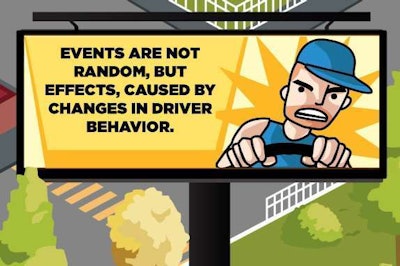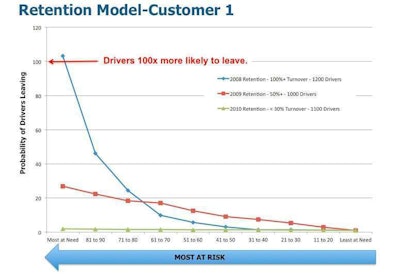 Click through this image for a lengthy FleetRisk infographic touting aggregate customer results from use of predictive analysis.
Click through this image for a lengthy FleetRisk infographic touting aggregate customer results from use of predictive analysis.Fleets deploying the data-analytics service available from the folks at FleetRisk Advisors have seen results that amount to a more than 80 percent reduction in accidents and a similarly sized drop in driver turnover. You might think of the predictive modeling FleetRisk does as a sort of “Moneyball” approach to accident prevention and other workplace improvement efforts. Essentially, FleetRisk, a business unit of Qualcomm’s Omnitracs fleet management device/software company, mines drivers’ operational data, including “tenure, compensation, safety and accident record, level of fatigue, and hours on the job,” they say on their website.
Running such data through proprietary predictive modeling engines, the company says, enables carriers to identify drivers at risk of safety-related events for the purposes of targeting fleet resources for particular drivers to reduce accidents as well as workers compensation claims on a fleet policy. FleetRisk is so convinced of the efficacy of what they’re doing, they’ve made pretty broad claims about use of predictive modeling in the future, where they see it figuring in all aspects of trucking industrywide.
Fair enough. But then there’s the driver-turnover piece. Check out this graph, showing three-year results from a company using FleetRisk’s predictive modeling to, well, tell them which drivers were most likely to leave the company.

Notice the vastly better turnover rate in the third year versus the first. Here’s my question for you: What do you think the fleet did in the interim after identifying those drivers most at risk of leaving?

I don’t know how easy it is to predict happiness levels from individual to individual, but I do know it ought to be a fairly simple task to keep a fleet’s turnover rates low. While carrier efforts at treating drivers better could involve all manner of things, there’s one aspect that you can bet on: It’s a three-letter word, rhymes with day.
In any case, if you’re leased to a carrier using the service, have you seen FleetRisk’s predictive analysis for your operation? What’s the verdict — will you be happy in five years? Enquiring minds want to know.










